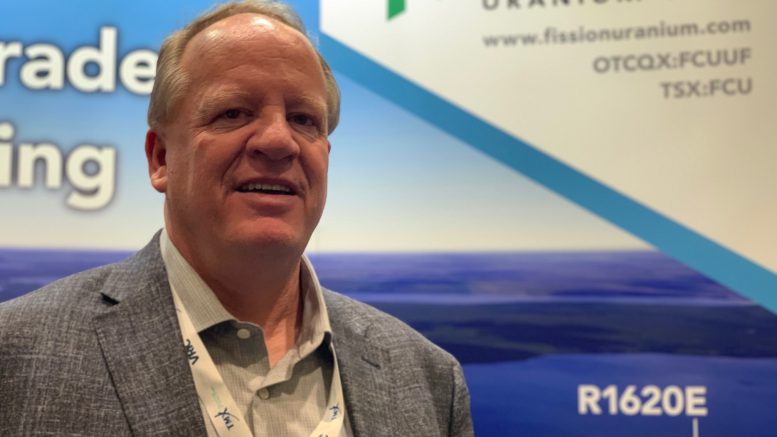With construction of its Patterson Lake South uranium mine planned to start in 2025, Fission Uranium (TSX: FCU; US-OTC: FCUUF) is managing important upcoming milestones to realize its vision of becoming a western Athabasca Basin uranium behemoth.
“It really is go-forward time for us,” president and CEO Ross McElroy, an established uranium expert credited with discovering the northern Saskatchewan project’s core Triple R deposit, tells The Northern Miner in an interview.
A key milestone on Fission’s timeline was submitting its initial application to the Canadian Nuclear Safety Commission in April. That followed the release in January of an updated feasibility study that boosted the project’s after-tax net present value by 70%. It has also been collaborating closely with provincial and federal governments to meet all regulatory standards.
“We are well into the depths of the permitting with both groups,” McElroy says, expecting the board to make a construction decision soon after permitting is completed sometime in 2025.
According to McElroy, the Triple R project’s feasibility study outlined a sliver of the project’s full potential.
The 310.4-sq.-km PLS project’s high-grade Triple R deposit contains probable reserves of 3 million tonnes of uranium grading 1.41% uranium oxide (U3O8) for 93.7 million lb. of contained metal.
PLS would have an after-tax internal rate of return of 27.2% and an after-tax net present value of $1.2 billion at an 8% discount, for average unit operating costs of less than US$10 per lb. of U3O8.
The study estimates a three-year construction period for the project, with production slated for 2029. Its mine life is 10 years.
McElroy points out that the findings “really spoke to the robustness of the project.”
Over the summer, the company has been progressing on its front-end engineering design for PLS, including collecting data from 772.6 metres of drilling to confirm feasibility-level assessments, geophysical surveys and hydrogeological holes to inform future underground mine planning.
Near-term catalysts
Post-feasibility, Fission is immersing itself in detailed engineering, setting the stage for the 2025 construction start. Its summer work focused on geotechnical efforts, particularly around the tailings management facility. McElroy states, “The next real major field work, as far as project development goes, is construction.”

Constructions at Fission Uranium’s Patterson Lake South project in Saskatchewan. Credit: Fission Uranium
In its quest to foster enduring community partnerships, Fission has been engaging with Indigenous communities.
On Jan. 12, the company announced it had signed a capacity funding agreement with the Métis Nation of Saskatchewan, about two months after it inked the same deal with the Birch Narrows Dene Nation, one of several Indigenous groups living in the region of PLS with whom Fission has inked agreements.
“We fully expect that we’ll get that kind of support; they’ve demonstrated a real desire for projects like this to go forward,” McElroy said. “All key Indigenous groups have entered into capacity funding agreements, and negotiations are ongoing for impact benefit agreements.
McElroy also said much of the summer was spent recruiting a top-tier roster of uranium experts to move the project forward. Fission expanded its technical team, opened offices in Saskatoon and La Loche, and appointed Eric Sylvestre as the community liaison coordinator.
The expanded team, which includes experts like Ryan Frey, Amitabha Majumder, Neil Chambers, and Thomas Bayer, brings a wealth of experience in various areas of uranium mining and community engagement.
Investors have taken notice of Fission’s forward momentum. Its share price has risen about 80% in the past six months. McElroy attributes this surge to the company’s strategic decisions and renewed interest in the uranium sector. Further adding to the excitement is the company’s exploration endeavours, with McElroy expressing confidence that they “can make substantial new discoveries on the PLS project.”
He said consolidation in the western Athabasca could make sense at some point in the future, given the proximity to NexGen Energy (TSX: NXE; NYSE: NXE; ASX: NXG) and its advanced Rook I project. He suggests there could be certain obvious opportunities to capitalize on synergies between the two projects, such as potentially sharing a central mill.
At 92.5¢ per share, Fission’s equity trading in Toronto is up 38% over the past 12 months, having touched 54¢ and $1.00. It has a market capitalization of $674.5 million.


Be the first to comment on "Fission set on 2025 Patterson Lake South construction start"